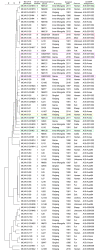Genetic characteristics of Bacillus anthracis isolated from northwestern China from 1990 to 2016
- PMID: 30418972
- PMCID: PMC6258423
- DOI: 10.1371/journal.pntd.0006908
Genetic characteristics of Bacillus anthracis isolated from northwestern China from 1990 to 2016
Abstract
Anthrax is a global re-emerging zoonotic disease and is an endemic disease in China, especially in rural regions. In this study, the general characteristics of human anthrax outbreaks that occurred in areas of northwestern China over the past decade have been described. Meanwhile, the genetic characteristics of Bacillus anthracis isolated from these areas from 1990 to 2016 were analyzed by means of canonical single-nucleotide polymorphism (canSNP) analysis and multilocus variable-number tandem repeat analysis (MLVA) with 15 markers. Five sublineages/subgroups, namely, A.Br.001/002, A.Br.Vollum, A.Br.Aust94, A.Br.Ames and A.Br.008/009, were detected by using 13 canSNP sites. All of the sublineages were found in Xinjiang province, while one sublineage was found in Shaanxi, two in Gansu, three in Qinghai and four in Inner Mongolia. However, the geographical distribution of the B. anthracis populations exhibited different canSNP characteristics from those of the strains isolated before 1990 in China. In contrast to previous data, the A.Br.Ames subgroup was also observed to be scattered from Inner Mongolia to other provinces. All 106 strains were assigned to 36 MLVA15 genotypes, and 21 of these types were first observed in this study. The strains collected from anthrax outbreaks in recent decade were classified as subgroups A.Br.001/002 and A.Br.Ames and identified as genotypes MLVA15-28, MLVA15-30, MLVA15-31, MLVA15-38, MLVA15-CHN3, and MLVA15-CHN18. By canSNP analysis and MLVA, we found that the diversification of MLVA genotypes and the geographical distribution of B. anthracis populations is gradually becoming balanced across northwestern China. This study also provides preliminary survey results regarding the population diversity of B. anthracis in China, which will help promote the prevention and control of this important disease.
Conflict of interest statement
The authors have declared that no competing interests exist.
Figures



References
-
- Fasanella A, Galante D, Garofolo G, Jones MH (2010) Anthrax undervalued zoonosis. Vet Microbiol 140: 318–331. 10.1016/j.vetmic.2009.08.016 - DOI - PubMed
-
- Doganay M, Demiraslan H (2015) Human anthrax as a re-emerging disease. Recent Pat Antiinfect Drug Discov 10: 10–29. - PubMed
-
- World Health Organization. The control of neglected zoonotic diseases: Community-based interventions for prevention and control. Geneva, 2010. Available: http://apps.who.int/iris/bitstream/10665/44746/1/9789241502528_eng.pdf.
-
- The Food and Agriculture Organization. Anthrax is affecting animals and humans. EMPRES Transbound Anim Dis Bull 2011; No 39. Available:http://www.fao.org/docrep/015/i2530e/i2530e00.pdf.
-
- World Health Organization. Anthrax in humans and animals. 4th ed. Geneva, 2008. - PubMed
Publication types
MeSH terms
LinkOut - more resources
Full Text Sources
Medical
Miscellaneous

